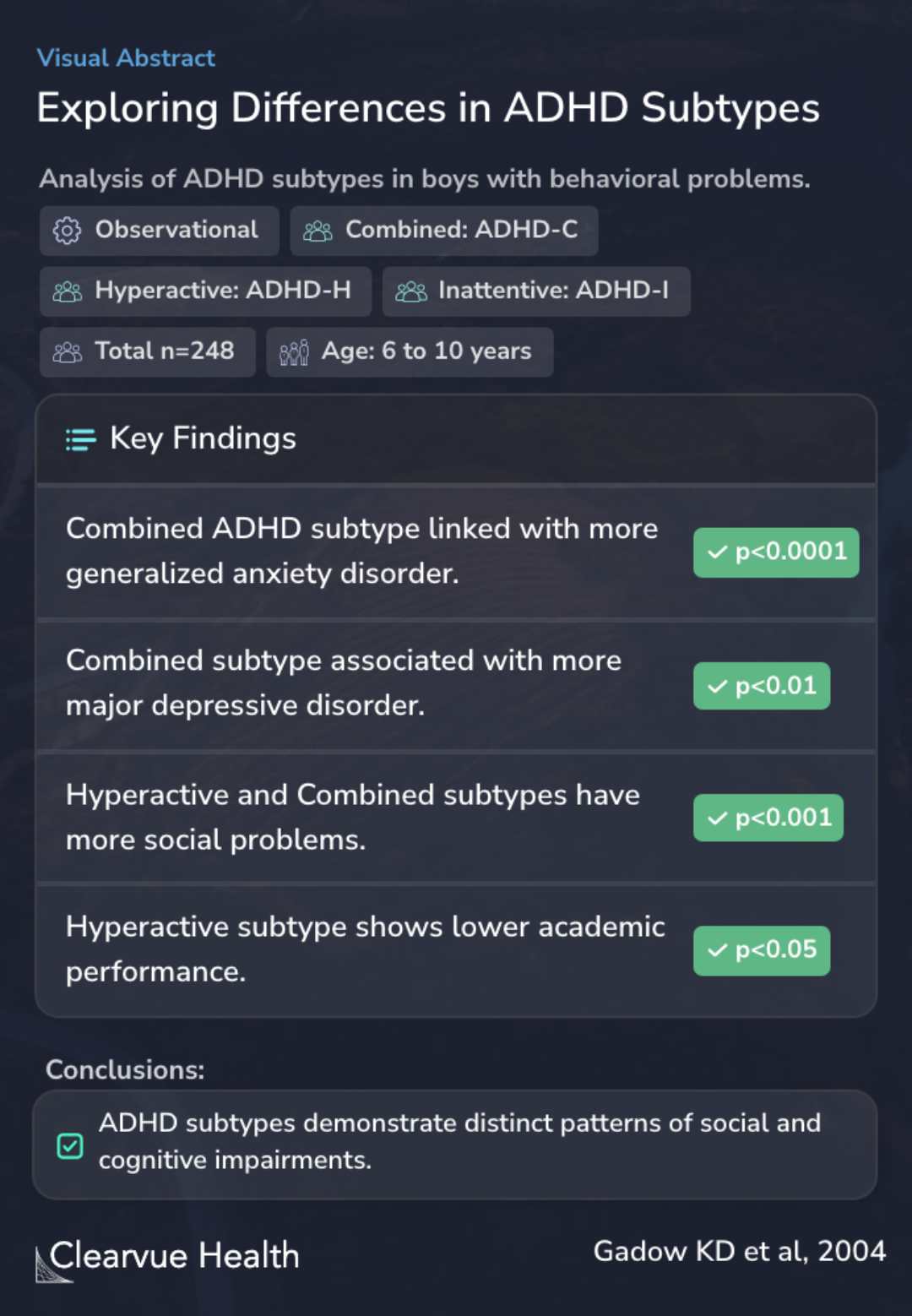Comparison of ADHD symptom subtypes as source-specific syndromes
Exploring Differences in ADHD Subtypes
Gadow KD, Drabick DA, Loney J, Sprafkin J, Salisbury H, Azizian A, Schwartz J

Objectives
This study delves into the differences between the three subtypes of attention-deficit/hyperactivity disorder (ADHD): inattentive (I), hyperactive-impulsive (H), and combined (C). It focuses on a diverse group of 248 boys, aged 6 to 10 years, all of whom are grappling with emotional and behavioral challenges. The study aims to understand how these ADHD subtypes manifest differently in this specific group.
This study examines differences between the three subtypes of attention-deficit/hyperactivity disorder (ADHD), inattentive (I), hyperactive-impulsive (H), and combined (C), in a heterogeneous sample of 248 boys (ages 6 to 10 years) with emotional and behavioral problems who were recruite...
Methods
The boys underwent thorough evaluations encompassing cognitive, behavioral, academic, and family functioning assessments. The study identified ADHD subtypes based on evaluations from both mothers and teachers, using the criteria set out in the DSM-IV, a manual for mental disorders.
The boys and their mothers participated in an extensive evaluation that involved multiple assessments of cognitive, behavioral, academic, and family functioning. ADHD subtypes were defined on the basis of teacher alone, mother alone, and mother/teacher ratings of DSM-IV symptoms.
Results
The findings highlight distinct patterns of impairment associated with different ADHD subtypes. Socially, both hyperactive (H) and combined (C) subtypes showed more challenges compared to the inattentive (I) subtype. Cognitively, the pattern was reversed, with the inattentive (I) and combined (C) subtypes facing more difficulties than the hyperactive (H) group. The combined (C) and hyperactive (H) groups were the most and least overall impaired, respectively, when compared to a non-ADHD clinical control group.
Results indicated ADHD symptom groups showed a differential pattern of impairment socially (H,C>I) and cognitively (I,C>H). The C and H groups were the most and least impaired overall, respectively, and all subtypes were differentiated from the nonADHD clinical control or NONE (N) group ...
Conclusions
These findings suggest that both mothers and teachers tend to interpret ADHD symptoms based on the behaviors most relevant to their daily interactions and concerns. The distinct patterns of social and cognitive impairments observed in ADHD subtypes underscore the complexity and variability of this disorder.
Observed findings are consistent with the notion that mothers and teachers interpret symptom statements in terms of behaviors that are most relevant for their daily concerns.
Key Takeaways
Context
This study's exploration of ADHD subtypes in young boys aligns with broader research on ADHD's varied manifestations and impacts. For instance, a study by Grizenko et al. (2010) found that the combined/hyperactive ADHD subtype exhibited more conduct disorder issues but responded better to treatment. They also identified differences in genetic markers between subtypes. Another research by Marshall RM et al. (1997) highlighted that students with ADD without hyperactivity had significantly lower math scores, pointing to distinct academic challenges faced by different subtypes.
These findings collectively highlight the nuanced nature of ADHD and its subtypes, emphasizing the need for tailored approaches in treatment and education. The current study contributes to this growing body of knowledge by offering specific insights into the behavioral and cognitive differences among ADHD subtypes in young boys.